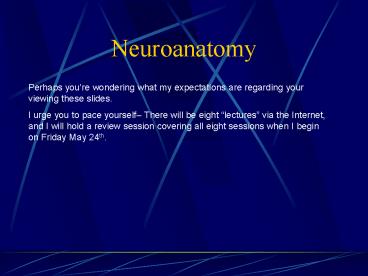Neuroanatomy - PowerPoint PPT Presentation
1 / 14
Title:
Neuroanatomy
Description:
... for the purposes of motor speech are sensation and proprioception. ... It mediates hearing and auditory comprehension. IV. Gross Anatomy. A. Cerebral Cortex ... – PowerPoint PPT presentation
Number of Views:158
Avg rating:3.0/5.0
Title: Neuroanatomy
1
Neuroanatomy
Perhaps youre wondering what my expectations are
regarding your viewing these slides. I urge you
to pace yourself There will be eight lectures
via the Internet, and I will hold a review
session covering all eight sessions when I begin
on Friday May 24th.
2
B. Peripheral Nervous System 1. Sensory
Nerves 2. Skeletal Nervous system Lower Motor
Neurons 1) Cranial Nerves 2) Spinal Nerves
3. Autonomic Nervous System a)
Parasympathetic b) Sympathetic
The sensory system is important to motor speech
production. We get constant feedback from our
articulators (as one example) regarding position
and shape of muscles as we speak.
3
(No Transcript)
4
Depending on which textbook youre reading, we
have 30 or 31 pairs of spinal nerves. Each of
these spinal nerves has two roots a dorsal and a
ventral root. You should realize by now that the
dorsal roots are the ones toward the back of the
back, and the ventral ones are well, ventral to
there or in a person standing, they would be
anterior to the dorsal roots. The dorsal roots
are the sensory roots. The sensory system
(which also includes the cranial nerves) includes
the peripheral receptor organs (so we have pain
and touch receptors, for example), the afferent
fibers that travel from a receptor end-organ to
the spinal cord, the dorsal root ganglia (located
just outside the dorsal root itself just outside
the spinal cord), the pathway up the spinal cord
and brainstem, portions of the thalamus, and the
pathways from the thalamus to the sensory cortex
(aka thalamocortical pathway).
5
IV. Gross Anatomy
- A. Cerebral Cortex
- 1. Lobes
- a. Frontal
Let me reiterate that I realize this is review
for you. However, I think the review will pay
off later in the course. So lets start with
the frontal lobes. They are certainly important
to motor speech.
6
Located in the rostral-most portion of the brain,
they are located anterior to the central sulcus,
and superior to the lateral (aka Sylvian)
fissure. Not only are discrete movements
mediated in the frontal lobes, but more complex
movements (involving larger groups of muscles)
are mediated anterior to the motor strip
7
IV. Gross Anatomy
- A. Cerebral Cortex
- 1. Lobes
- a. Frontal
- b. Parietal
The parietal lobe is next.
8
The parietal lobe is posterior to the central
sulcus. The most important functions mediated by
the frontal lobes for the purposes of motor
speech are sensation and proprioception. The
sensory strip is the anterior-most (rostral-most)
portion of the parietal lobe. The angular gyrus
is also located in the parietal lobe (by most
anatomists, it is), which mediates reading and
writing.
9
IV. Gross Anatomy
- A. Cerebral Cortex
- 1. Lobes
- a. Frontal
- b. Parietal
- c. Temporal
Next we have the temporal lobe.
10
The temporal lobe is inferior to the parietal
lobe, anterior to the occipital lobe, and
inferior/posterior to the frontal lobes. It
mediates hearing and auditory comprehension.
11
IV. Gross Anatomy
- A. Cerebral Cortex
- 1. Lobes
- a. Frontal
- b. Parietal
- c. Temporal
- d. Occipital
We also have the occipital lobe.
12
The parietal-occipital sulcus is the anterior
boundary of the occipital lobe, which mediates
visual functions.
13
IV. Gross Anatomy
- A. Cerebral Cortex
- 1. Lobes
- a. Frontal
- b. Parietal
- c. Temporal
- d. Occipital
- e. Insula
Finally we have the insula.
14
The insula is deep to the frontal and parietal
lobes as you can see in this slide. Damage to
the insula can result in apraxia of speech,
although we do not have as much data on the
insula as we do for other structures.
















![READ [PDF] Atlas of Neuroanatomy and Special Sense Organs PowerPoint PPT Presentation](https://s3.amazonaws.com/images.powershow.com/10075116.th0.jpg?_=20240709094)





![[PDF] Neuroanatomy : An Illustrated Colour Text Free PowerPoint PPT Presentation](https://s3.amazonaws.com/images.powershow.com/10082458.th0.jpg?_=20240720116)
![[PDF] Neuroanatomy Coloring Book: Human Brain Coloring Book for Neuroscience and Neuroanatomy Workbook Free PowerPoint PPT Presentation](https://s3.amazonaws.com/images.powershow.com/10082460.th0.jpg?_=20240720117)
![[PDF] Neuroanatomy Text and Atlas Ipad PowerPoint PPT Presentation](https://s3.amazonaws.com/images.powershow.com/10082462.th0.jpg?_=20240720118)






